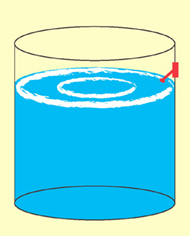Extending Pump Motor Life in Liquid Level Applications
www.emssensors.com, Maintenance Technology
Many process systems operate by the storage, transfer, metering, and disposal of liquid materials. The pumps that move the liquid materials represent a point where maintenance failure can halt all other processes. Extending the service life of pump motors and these critical process components can significantly reduce process as well as maintenance costs.
Most often the decision to turn pumps on and off is based on the level of a liquid in a storage vessel. Fig. 1 shows a simple single point float switch. When the level of the liquid falls below the float switch, the pump motor is turned on to bring the level high enough to open the switch and stop the pump. This maintains a constant level.
(Safety note: Pump motor operating voltages such as 110/220 V ac should not be run directly through liquid switches. Low voltage control signals should be used to operate relays that switch the pump motors on and off.)
The Fig. 1 application is well suited to keeping a constant level and it is relatively low in cost and installation. However, from a maintenance point of view, the pump motor is being run frequently and for short periods. This provides for the greatest pump impeller and pump motor bearing wear.
Fig. 1. Simple single point float switch turns on the pump motor when the level of the liquid falls below the switch.
Also, from a process design perspective, the single point level control may not provide the fluid turnover desired and could lead to a buildup of sludge or other material.
Fig. 2 illustrates an application that uses two float switches. A high and low level can be selected that reduces the wear on pumps and motors as well as insures a high level of liquid turnover. In this application the pump turns on when the low level is detected and turns off when the high level is detected.
Fig. 2. Two float switches which allow a high and low level to be selected can prevent overflow or spill conditions.
In some critical applications an additional switch is installed to detect a high level above the pump shutoff point. This can help prevent costly overflow or spill conditions.
There are some applications where it is not possible to mount float switches at the desired points in the vessel wall. For these situations float switches can be suspended from the top of the storage vessel as shown in Fig. 3.
Fig. 3. Float switches can be suspended when it is not possible to mount them on the vessel wall.
For applications where the liquid material may foul a mechanical switch, alternative sensing can be used. It is possible to mount a pressure sensor at the bottom of the vessel as shown in Fig. 4. A control is needed to convert the pressure information into level information and to program the high and low setpoints. An ultrasonic sensor also can be used to determine the level of a liquid.
Fig. 4. Pressure sensors can be mounted at the bottom of a vessel along with a control to convert the pressure information into level information. An ultrasonic sensor also can be used.
Regardless of whether the high and low set points are mechanically determined or programmed into a control, they need to be selected with a view toward keeping pump motors from the frequent start and stop cycles that accelerate wear, failure, and consequently, maintenance.
Information supplied by Tim Froehlke, applications engineer, EMS Sensors, 2600 Salem Ave., St. Louis Park, MN 55416; (952) 922-2028; www.emssensors.com, Maintenance Technology










